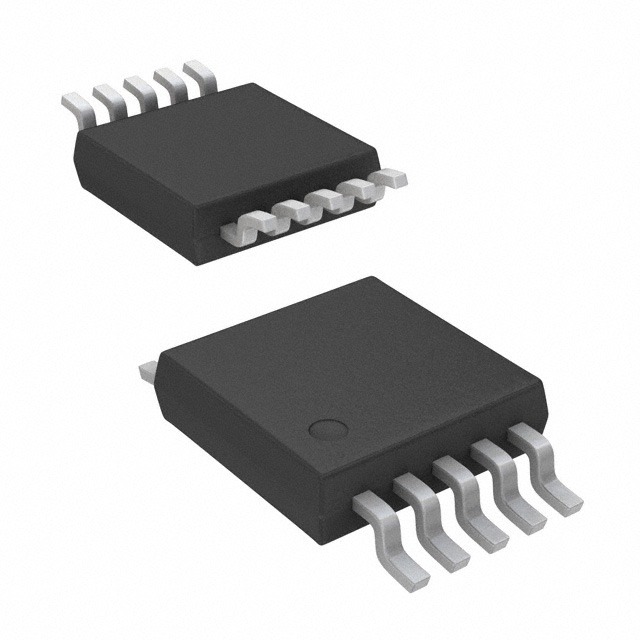AD5248BRM100-RL7
Product Overview
Category
The AD5248BRM100-RL7 belongs to the category of integrated digital potentiometers.
Use
It is primarily used for electronic circuitry and control systems where variable resistance is required.
Characteristics
- Integrated digital potentiometer with 256 positions
- Low temperature coefficient
- Wide operating voltage range
- High resolution and accuracy
- Non-volatile memory for storing settings
- Serial interface for easy control
Package
The AD5248BRM100-RL7 comes in a small outline package (SOP) with 10 pins.
Essence
This product serves as a replacement for traditional mechanical potentiometers, providing a digitally controlled variable resistance.
Packaging/Quantity
The AD5248BRM100-RL7 is typically packaged in reels containing 2500 units.
Specifications
- Resolution: 8 bits (256 positions)
- Operating Voltage Range: 2.7V to 5.5V
- Temperature Coefficient: ±35 ppm/°C
- End-to-End Resistance Range: 100 kΩ
- Interface: I2C-compatible serial interface
Pin Configuration
The AD5248BRM100-RL7 has the following pin configuration:
- VDD - Power supply voltage
- SDA - Serial data input/output
- SCL - Serial clock input
- A0 - Address bit 0
- A1 - Address bit 1
- WP - Write protect input
- VSS - Ground
- RDAC - Resistor terminal A
- RDAC - Resistor terminal B
- VLOGIC - Logic power supply voltage
Functional Features
- Digital control of resistance value
- Non-volatile memory for storing settings
- Low power consumption
- High reliability and durability
- Wide operating temperature range
Advantages and Disadvantages
Advantages
- Precise and accurate resistance control
- Easy integration into digital systems
- Eliminates mechanical wear and tear
- Saves space compared to traditional potentiometers
- Non-volatile memory ensures settings are retained
Disadvantages
- Limited resolution compared to higher-bit digital potentiometers
- Sensitive to electrostatic discharge (ESD)
- Higher cost compared to mechanical potentiometers
Working Principles
The AD5248BRM100-RL7 utilizes a combination of digital-to-analog conversion and resistor ladder network techniques. The digital control signals received through the serial interface are converted into specific resistance values, allowing precise control over the output voltage or current in electronic circuits.
Detailed Application Field Plans
The AD5248BRM100-RL7 finds applications in various fields, including:
- Audio equipment: Volume control, tone adjustment
- Instrumentation: Calibration, signal conditioning
- Industrial automation: Process control, motor speed control
- Communication systems: Signal amplification, equalization
- Automotive electronics: Climate control, lighting control
Detailed and Complete Alternative Models
- AD5241BRZ10 - 10 kΩ, 8-bit digital potentiometer
- AD5242BRUZ50 - 50 kΩ, 8-bit digital potentiometer
- AD5244BRUZ20 - 20 kΩ, 8-bit quad digital potentiometer
- AD5259BRMZ10 - 10 kΩ, 256-position digital potentiometer with non-volatile memory
These alternative models offer similar functionality and can be considered as alternatives to the AD5248BRM100-RL7 based on specific application requirements.
In conclusion, the AD5248BRM100-RL7 is a versatile integrated digital potentiometer that provides precise resistance control in various electronic systems. Its compact size, high resolution, and non-volatile memory make it an ideal choice for applications requiring accurate and reliable resistance adjustment.
Lista 10 Vanliga frågor och svar relaterade till tillämpningen av AD5248BRM100-RL7 i tekniska lösningar
Sure! Here are 10 common questions and answers related to the application of AD5248BRM100-RL7 in technical solutions:
Q: What is the AD5248BRM100-RL7? A: The AD5248BRM100-RL7 is a digital potentiometer IC (integrated circuit) with 100kΩ resistance, manufactured by Analog Devices.
Q: What are the key features of the AD5248BRM100-RL7? A: The key features include 256-tap positions, I2C interface, low temperature coefficient, and low power consumption.
Q: How can I control the AD5248BRM100-RL7? A: You can control the AD5248BRM100-RL7 using the I2C bus protocol, which allows for easy communication with microcontrollers or other devices.
Q: What are some typical applications of the AD5248BRM100-RL7? A: The AD5248BRM100-RL7 is commonly used in audio equipment, instrumentation, industrial control systems, and other applications where precise resistance adjustment is required.
Q: Can I use multiple AD5248BRM100-RL7 ICs together? A: Yes, you can daisy-chain multiple AD5248BRM100-RL7 ICs to increase the number of available taps or control multiple channels simultaneously.
Q: What is the resolution of the AD5248BRM100-RL7? A: The AD5248BRM100-RL7 has a resolution of 8 bits, providing 256 possible tap positions.
Q: What is the power supply voltage range for the AD5248BRM100-RL7? A: The AD5248BRM100-RL7 operates from a single power supply voltage range of 2.7V to 5.5V.
Q: Does the AD5248BRM100-RL7 have non-volatile memory? A: Yes, the AD5248BRM100-RL7 has non-volatile memory that allows it to retain its settings even when power is removed.
Q: Can I use the AD5248BRM100-RL7 in harsh environments? A: The AD5248BRM100-RL7 is designed to operate in industrial temperature ranges (-40°C to +125°C) and is suitable for many harsh environment applications.
Q: Are there any evaluation boards or development tools available for the AD5248BRM100-RL7? A: Yes, Analog Devices provides evaluation boards and software tools to help with the development and testing of applications using the AD5248BRM100-RL7.
Please note that these answers are general and may vary depending on specific application requirements.


